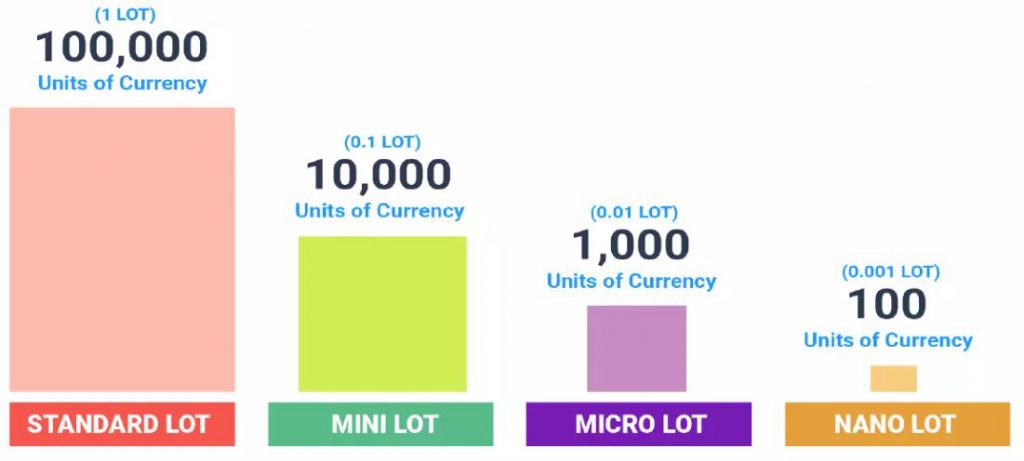Introduction
In forex trading, understanding lot sizes is essential. Whether you’re new to trading or an experienced trader, knowing how to manage lot sizes can significantly impact your success. This guide will help you understand forex lots, choose the right lot size, and implement effective trading strategies.
Introduction to Forex Lots
When trading forex, you are engaging in the buying and selling of currency pairs. A “lot” refers to the size of the position you are trading, which directly influences the volume of currency involved and consequently, the potential risk and profit of the trade.
Importance of Lot Sizes
Lot sizes are a fundamental aspect of forex trading because they determine the magnitude of your trades. The size of the lot you choose can greatly affect both your potential profit and the risk you are taking on with each trade.

Types of Forex Lots
There are four primary types of forex lots: standard, mini, micro, and nano. Each type serves different trading needs and risk appetites.
Standard Lots
A standard lot is the largest size, comprising 100,000 units of the base currency. This size is generally used by institutional traders or those with substantial trading capital due to the higher potential for both profit and loss.
Mini Lots
A mini lot consists of 10,000 units, making it one-tenth of a standard lot. It is popular among retail traders who seek to trade significant volumes without the higher risks associated with standard lots.
Micro Lots
A micro lot is composed of 1,000 units. This size is particularly suitable for beginners or traders with limited capital, as it allows for smaller, less risky trades.
Nano Lots
Nano lots are the smallest, with 100 units. They are ideal for new traders or those testing trading strategies with minimal financial exposure.
Choosing the Right Lot Size
Choosing the correct lot size is vital and should be based on multiple factors:
Trading Capital: Match your lot size to your available trading capital to avoid overextending yourself and facing significant losses.
Risk Tolerance: Choose a lot size that aligns with your comfort level for risk. Smaller lot sizes typically mean lower risk.

Trading Strategy: Your trading strategy should guide your lot size decision. For instance, scalpers may prefer smaller lots, while swing traders might use larger ones.
Calculating Lot Sizes
Follow these steps to identify the appropriate lot size for your trades:
Determine Risk Per Trade: Decide how much of your capital you are willing to risk on a single trade, typically between 1-2%.
Calculate Pip Value: Understand the pip value for the currency pairs you are trading, as it varies with the lot size.
Leverage position size calculators available online to determine the ideal lot size, considering your risk tolerance and the pip value.
Risk Management with Lot Sizes
Effective risk management is essential for successful trading. Here are some tips:
Implement stop-loss orders to cap potential losses, tailoring them to your risk threshold and the current market volatility.
Diversify Trades: Spread your risk by trading multiple currency pairs and varying lot sizes.
Adjust Lot Sizes: Modify your lot sizes in response to changing market conditions to better manage risk.
Lot Sizes and Leverage
Leverage allows traders to control larger positions with a smaller amount of capital, amplifying both potential profits and risks. Balancing leverage with appropriate lot sizes is key to successful trading.
How Leverage Works
Leverage is expressed as a ratio, such as 100:1, which means you can control a position 100 times larger than your capital. For example, $1,000 with 100:1 leverage can control a $100,000 position.
Balancing Leverage and Lot Sizes
Using excessive leverage with large lot sizes can lead to significant losses. Ensure you balance leverage with suitable lot sizes to manage your risk effectively.
Effective Strategies
Successful traders use various strategies to optimize their lot sizes:
Fixed Lot Size Strategy
This strategy involves using the same lot size for every trade, regardless of market conditions. While simple to implement, it may not suit all traders.
Variable Lot Size Strategy
Adjusting lot sizes based on market conditions and risk tolerance can enhance your trading effectiveness. Smaller lot sizes can be used in volatile markets and larger ones in stable markets.
Proportional Lot Size Strategy
This strategy determines lot sizes as a percentage of your trading capital, helping manage risk by ensuring no single trade risks too much of your account.
Common Mistakes
Avoid these common pitfalls in forex trading:
Overleveraging: Using too much leverage with large lot sizes can lead to substantial losses. Balance leverage with appropriate lot sizes.
Ignoring Risk Management: Failing to use stop-loss orders and diversify trades can result in significant losses.
Trading Without a Strategy: Entering trades without a clear strategy can lead to inconsistent results. Always stick to a trading plan.
Adapting to Market Conditions
Market conditions fluctuate, so it’s important to adjust your lot sizes accordingly:
Volatile Markets: Use smaller lot sizes to reduce risk in volatile markets.
Stable Markets: Larger lot sizes can be effective in stable markets, capitalizing on smaller price movements.
Economic Events: Major economic events can impact the forex market. Be prepared to adjust lot sizes to manage risk effectively.
Conclusion Understanding and managing lot sizes is fundamental to successful forex trading. By selecting the right lot size and employing effective risk management strategies, you can optimize your trades and enhance your profitability. Whether you are a novice or an experienced trader, these insights will help you navigate lot sizes and improve your trading outcomes.


